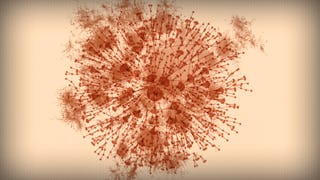IaaS vs. PaaS vs. SaaS: Intro to Cloud Computing
July 8, 2024
Article



This course is part of Data Visualization Specialization

Instructor: Jesus Caban
Included with 
Recommended experience
Intermediate level
A basic understanding of data visualization, 3D graphics, and statistical concepts is recommended.
Recommended experience
Intermediate level
A basic understanding of data visualization, 3D graphics, and statistical concepts is recommended.
Visualize temporal data and identify trends over time using advanced techniques tailored to time-based datasets and scientific data representation.
Represent volumetric and 3D data using visualization methods, including medical imaging techniques for complex scientific datasets.
Apply direct volume rendering methods and transfer functions to enhance data clarity in non-photorealistic visualizations.
Evaluate and validate visualizations across various systems, ensuring accuracy, effectiveness, and scalability.

Add to your LinkedIn profile
January 2025
15 assignments



Add this credential to your LinkedIn profile, resume, or CV
Share it on social media and in your performance review

The course "Specialized Data Visualization Approaches" explores advanced data visualization techniques, equipping you with the skills to tackle complex data challenges. You’ll learn how to visualize temporal, volumetric, and multidimensional data, leveraging specialized methods such as direct volume rendering, isosurfaces, and flow visualization. With a focus on scientific accuracy and practical applications, you'll gain the tools to represent data over time and visualize 3D datasets for fields like engineering and medicine. By applying these techniques, you’ll enhance your ability to create insightful and impactful visualizations for various domains.
What sets this course apart is its emphasis on evaluating and validating visualizations for effectiveness, ensuring that your visual outputs are not only technically advanced but also user-friendly and accurate. Whether you’re working in research, engineering, or any field that requires advanced data analysis, this course will help you build the expertise to communicate complex insights with clarity and precision.
This course delves into specialized visualization methods, encompassing temporal and scientific visualizations, advanced rendering techniques, and evaluation metrics for visualizations. You will acquire a thorough understanding of how to apply these techniques to address complex data challenges and assess the effectiveness of their visualizations.
2 readings
In this module, you will dive into the unique challenges and methods for visualizing temporal data, which represents information over time. You will learn about the different types of temporal data and the tasks commonly associated with analyzing it, such as identifying trends and patterns. This module also introduces basic temporal representations, equipping learners with foundational techniques to effectively visualize time-based data. By the end, you will be prepared to choose and apply suitable visualizations for diverse temporal data scenarios.
4 videos3 readings3 assignments
In this module, you will explore advanced concepts in scientific visualization, focusing on the representation of volumetric data essential for fields like medicine and engineering. You will gain insights into 3D data acquisition systems used in medical imaging and examine various techniques for visualizing complex 3D datasets. This module provides the tools and knowledge needed to create meaningful visual representations of volumetric data, enabling clearer insights into dense and layered information.
4 videos3 readings3 assignments1 ungraded lab
This module introduces learners to the specialized techniques of flow visualization and non-photorealistic volume rendering, focusing on methods for enhancing clarity and interpretability in complex visualizations. You will learn about direct volume rendering principles, explore the ray casting process, and examine how transfer functions—including gradient, curvature, and texture-based—can alter visualization properties for clearer data interpretation. Through examples of volume data, this module equips you with advanced skills to create insightful, non-photorealistic visual representations of intricate datasets.
3 videos3 readings3 assignments
In this module, you will explore advanced techniques in visual analytics, focusing on methods for interpreting complex data structures such as vector fields. You will learn about isosurface visualization and the fundamentals of the marching cubes algorithm, widely used for rendering 3D surfaces. The module also covers non-photorealistic rendering techniques and key attributes of vector fields, providing a toolkit of visualization methods for effectively analyzing and representing multidimensional data. By the end, you will have a robust understanding of visual analytics for sophisticated data types.
3 videos3 readings3 assignments
This final module evaluates and validates visualization systems to ensure effectiveness and scalability across various display mediums. You will learn about different platforms for showcasing visualizations, techniques for building scalable display systems, and approaches to validating visualization designs for accuracy and user comprehension. By the end of this module, you will be equipped with the skills to critically assess and refine visualization systems for a wide range of applications and audiences.
3 videos3 readings3 assignments



The mission of The Johns Hopkins University is to educate its students and cultivate their capacity for life-long learning, to foster independent and original research, and to bring the benefits of discovery to the world.


Johns Hopkins University
Specialization


University of Illinois Urbana-Champaign
Course


Johns Hopkins University
Course


Johns Hopkins University
Course





Unlimited access to 10,000+ world-class courses, hands-on projects, and job-ready certificate programs - all included in your subscription
Earn a degree from world-class universities - 100% online
Upskill your employees to excel in the digital economy
Access to lectures and assignments depends on your type of enrollment. If you take a course in audit mode, you will be able to see most course materials for free. To access graded assignments and to earn a Certificate, you will need to purchase the Certificate experience, during or after your audit. If you don't see the audit option:
The course may not offer an audit option. You can try a Free Trial instead, or apply for Financial Aid.
The course may offer 'Full Course, No Certificate' instead. This option lets you see all course materials, submit required assessments, and get a final grade. This also means that you will not be able to purchase a Certificate experience.
When you enroll in the course, you get access to all of the courses in the Specialization, and you earn a certificate when you complete the work. Your electronic Certificate will be added to your Accomplishments page - from there, you can print your Certificate or add it to your LinkedIn profile. If you only want to read and view the course content, you can audit the course for free.
If you subscribed, you get a 7-day free trial during which you can cancel at no penalty. After that, we don’t give refunds, but you can cancel your subscription at any time. See our full refund policy.
Yes. In select learning programs, you can apply for financial aid or a scholarship if you can’t afford the enrollment fee. If fin aid or scholarship is available for your learning program selection, you’ll find a link to apply on the description page.